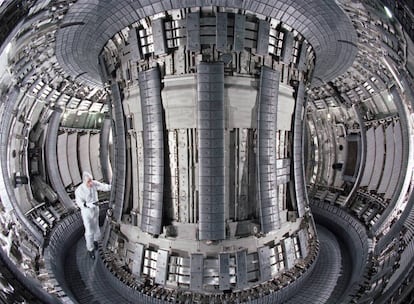Lack of government threatens Spain’s role in Europe’s future energy strategy
Can politicians prepare the country’s bid to host an EU test facility for nuclear fusion in time?

By 2050, Europe intends to run on clean, limitless energy, relegating fossil fuel to history, and the way it plans to do this is through nuclear fusion.
Atomic energy has always been controversial, and concerns about its risks have increased following the Fukushima disaster in 2011. But nuclear fusion is now being promoted as a much safer alternative, and one that generates far less radioactive waste.
Scientists believe it is possible to build a reactor capable of generating these kinds of temperatures that would be able to produce 10 times more energy than we consume
The difference between fission, the process used until now to generate nuclear power, and fusion, is that instead of splitting the atom, fusion melds them together, which produces less radioactive waste. Furthermore, say some scientists, when the right atoms are chosen, the procedure may produce no waste at all.
Fusion is what powers the Sun and the stars and makes life on Earth possible. In order to reproduce this process on earth, we need temperatures of around 150 million ºC – 10 times as intense as the sun’s core.
Now scientists believe it is possible to build a reactor capable of generating these kinds of temperatures that would be able to produce 10 times more energy than we consume, thereby solving the world’s energy problems.
Turning the theory into reality is one of the biggest challenges currently facing mankind. To do that, test facilities to carry out experiments are required such as ITER, under construction in the south of France. But the EU’s roadmap also includes building an International Fusion Materials Irradiation Facility (IFMIF), or particle accelerator, a joint European/Japanese project to test materials.
Over the last year Granada, in Andalusia, has been in the running to be the site of the IFMIF. The bid, however, involves Andalusia’s regional government working with the central government to come up with a proposal. And according to Spanish scientists, the current impasse following inconclusive elections in December, which are to be repeated on June 26, has seen little progress.
“We have no clear idea what is happening between the central government and the regional government,” says Ángel Ibarra, a scientist from the Centre of Research into Energy, Environment and Technology (Ciemat) and one of the team tasked with designing the new facility.
According to Spanish scientists, the current impasse following inconclusive elections in December has seen little progress
But the European Union is not about to wait for Spain. With a budget of hundreds of millions of euros, they want this facility built and actively testing by 2022 as planned, says Ibarra.
Neither the ITER facility nor the IFMIF would ever generate electricity. Instead, they would be the precursors to a future reactor to be built towards the end of the 2030s, which in turn will precede commercial reactors. “The EU’s goal is to be producing electricity from fusion by 2050 and for that to happen, we needed to be getting started on the reactor’s design now,” says Ibarra.
The cost of this facility is around €360 million, but if Spain’s bid is successful, it would create 360 directly related posts along with a further 12,000 indirect jobs. Estimates suggest the economic benefits would amount to €900 million, and though its lifespan as a test facility would be just 10 years, there is potential for it to be adapted and used in 2050 as a commercial plant.
“This particle accelerator would be the most powerful the world, more powerful than the Large Hadron Collider (LHC),” says Ibarra, referring to the European Organization for Nuclear Research’s particle collider, which is carved into a Swiss mountainside, and is the largest, most complex experimental facility ever built, but the IFMIF would produce a much greater number of particles. It would also be the biggest scientific facility ever built in Spain, as well as a strategic base for the European Union.
“It would be difficult to find a more worthwhile project,” says Javier Díaz of Granada University and a member of the team preparing Spain’s bid. “We need action from both the regional government and the Ministry. Without this commitment, the message we’re sending is very ambiguous,” he says.
If Spain’s bid is successful, it would create 360 directly related posts along with a further 12,000 indirect jobs
The other main European contender is Poland, which may beat Spain in presenting a proposal, despite lagging in fusion technology. “Poland hasn't got a final proposal together, but it is being more active than we are,” says Joaquin Sánchez, a member of Ciemat’s fusion team. “In Spain, there are so many people involved that nobody knows exactly who is holding things up.”
Other countries showing an interest include Croatia, while Japan, already hosting one of the test facilities, will be another contender if no European country comes forward with a viable proposal.
“After Japan, Spain is the most qualified,” says Sánchez, explaining that the country contributes as much as Italy and France to IFMIF and that Spanish companies have played a major role in the development of fusion. As far as the ITER facility in France is concerned, Spain is in the top three for technological contracts.
But Sánchez says Spain risks losing its advantage. “If another candidate begins to move quickly, we’re lost,” he says. “The deadline for deciding where to build the project is the end of the year although that's still not down in writing,” he says.
Sign up for our newsletter
EL PAÍS English Edition is launching a weekly newsletter. Sign up today to receive a selection of our best stories in your inbox every Saturday morning. For full details about how to subscribe, click here.
The Spanish government has expressed its interest in hosting the facility via a letter from the Secretary of State for Research and Development, which is ultimately dependent on the Treasury. The plan would be to finance at least 50% of the facility by drawing on European regional development funds, plus 20% from the regional government of Andalusia.
The regional government and the central government last met on April 26. Both parties have expressed interest in the project but they haven't hammered out a final proposal or even arranged a date for a follow-up meeting.
English version by Heather Galloway.
Tu suscripción se está usando en otro dispositivo
¿Quieres añadir otro usuario a tu suscripción?
Si continúas leyendo en este dispositivo, no se podrá leer en el otro.
FlechaTu suscripción se está usando en otro dispositivo y solo puedes acceder a EL PAÍS desde un dispositivo a la vez.
Si quieres compartir tu cuenta, cambia tu suscripción a la modalidad Premium, así podrás añadir otro usuario. Cada uno accederá con su propia cuenta de email, lo que os permitirá personalizar vuestra experiencia en EL PAÍS.
¿Tienes una suscripción de empresa? Accede aquí para contratar más cuentas.
En el caso de no saber quién está usando tu cuenta, te recomendamos cambiar tu contraseña aquí.
Si decides continuar compartiendo tu cuenta, este mensaje se mostrará en tu dispositivo y en el de la otra persona que está usando tu cuenta de forma indefinida, afectando a tu experiencia de lectura. Puedes consultar aquí los términos y condiciones de la suscripción digital.
More information
Archived In
Últimas noticias
The complicated life of Francesca Albanese: A rising figure in Italy but barred from every bank by Trump’s sanctions
Half of Scotland is in the hands of 420 property owners
Reinhard Genzel, Nobel laureate in physics: ‘One-minute videos will never give you the truth’
Pinochet’s victims grapple with José Antonio Kast’s rise in Chile
Most viewed
- Why we lost the habit of sleeping in two segments and how that changed our sense of time
- Trump’s obsession with putting his name on everything is unprecedented in the United States
- Charles Dubouloz, mountaineering star, retires at 36 with a farewell tour inspired by Walter Bonatti
- The Florida Keys tourist paradise is besieged by immigration agents: ‘We’ve never seen anything like this’
- Living in a motorhome due to soaring housing prices in Madrid: ‘I got used to it quickly, but I don’t idealize it’










































